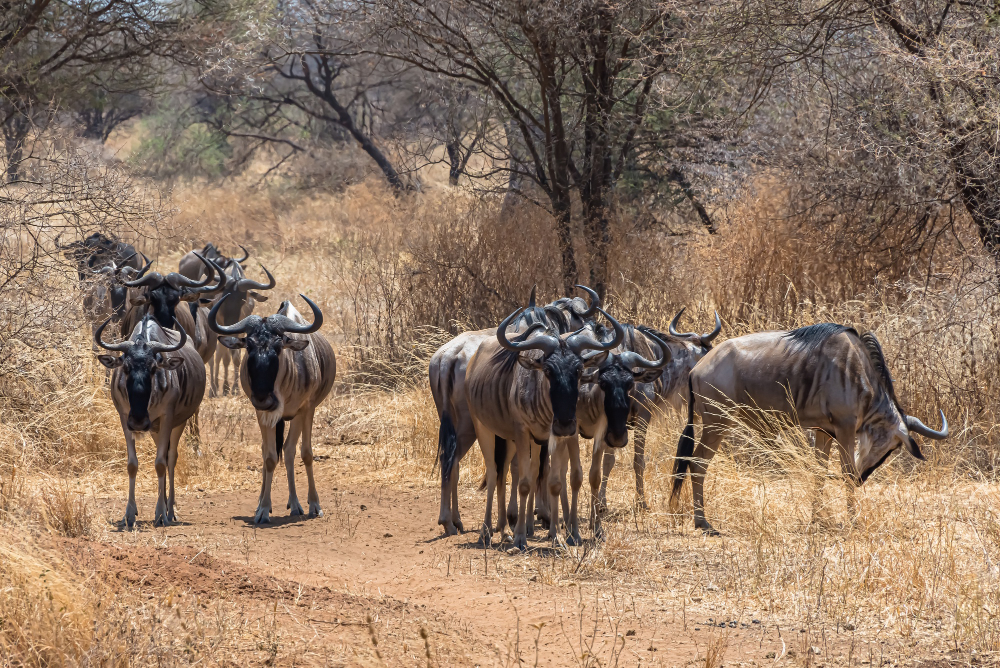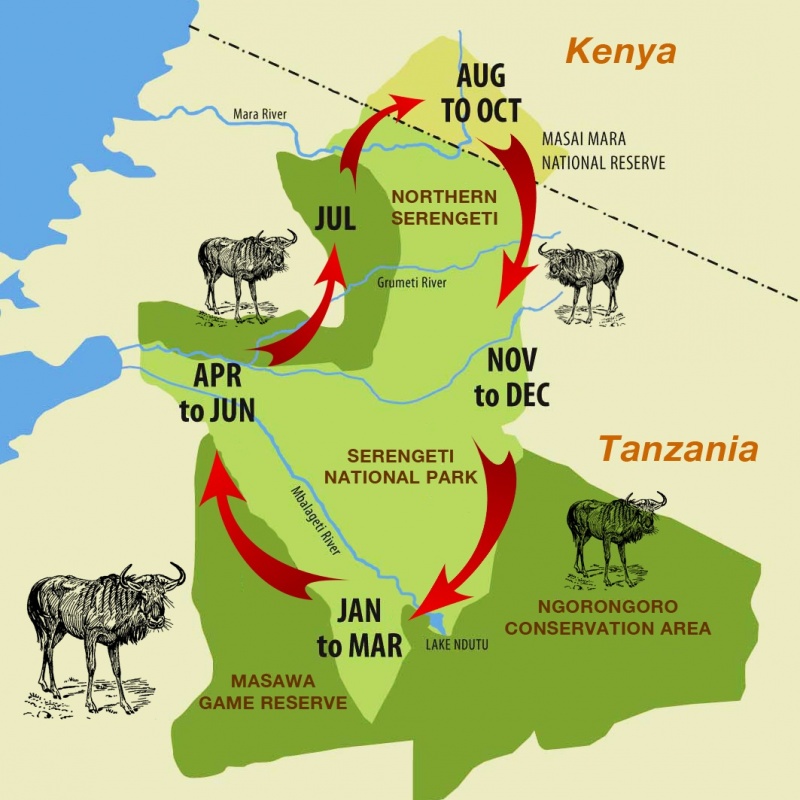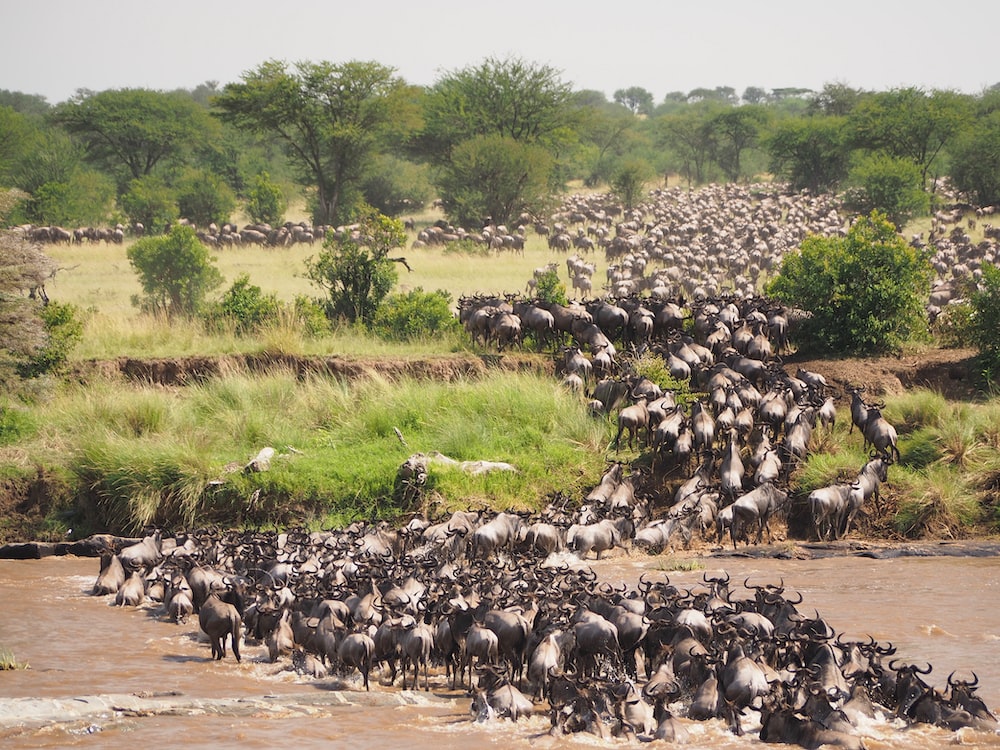
Witnessing the Annual Wildebeest Migration in East Africa
Posted on June 7, 2023
The Annual Wildebeest Migration circle
The annual wildebeest migration is one of the world’s most phenomenal wildlife events. It’s a spectacle that transcends words, leaving a lasting impression on those fortunate enough to witness it. For travelers and wildlife enthusiasts, it is a bucket list experience – a grand pageant of life in the African savannah.
A Second Introduction: The Magnitude of the Annual Wildebeest Migration
But why does the annual wildebeest migration capture our imagination? To put it simply, it’s the sheer magnitude. Over a million wildebeest are journeying together across vast plains and treacherous rivers. The sounds, the sights, the intrinsic rhythm of life pulsating in this mass movement. Truly, it’s an incredible display of nature’s wonders.
The Wildebeest: A Brief Overview
Before diving deeper into the annual wildebeest migration, let’s get to know the wildebeest. Contrary to popular belief, wildebeests aren’t just ordinary antelopes. With distinctive features and social behavior, they are as unique as the spectacle they create. Wildebeests live in a complex, interconnected community, presenting a fascinating study of animal behavior.
More on The Wildebeest: Unique Antelopes
Despite their ungainly appearance, wildebeests are well-adapted to their environment. They can run swiftly to escape predators, and their impressive stamina enables the strenuous migration journey. Moreover, their decision-making in terms of migration path is a spectacle of collective intelligence.
Understanding the Great Annual Wildebeest Migration
The Great Migration is a cyclic, instinct-driven journey in search of greener pastures. Over a million wildebeests, joined by thousands of zebras and gazelles, partake in this life-or-death voyage. It’s a remarkable show of nature’s resilience, inspired by the rhythm of weather and the promise of survival.
Annual Wildebeest migration circle
While the prime focus of the is between July to October, much is less said on the annual wildebeest migration that happens all year-round from January to December. This is important while choosing where to stay although some lodges and camps like Acacia lodges and camps are strategically located for this.

January-February
The herds enjoy the short grass plains of southern Serengeti, Ndutu area and the northern part of Ngorongoro Conservation Area. The mother hooves prepare to give birth as the calving season commences by the end of January. Every day during this season, about 8,000 baby wildebeests are born. It’s amazing to watch them walk in less than 15 minutes after birth and able to match speed of their migrating mother. While adult wildebeest’s barricade around their young and fragile mothers, hungry predators plan for a savage attack.
March
The last batches of calves are being born and the hooves prepare to move northwards. You can expect the herds to be dispersed across the southern Serengeti plains, feeding on what little grasses are left. Rains also sometimes start at the end of March.
April-May
Considered the wettest months of the year in Tanzania; Due to the long rains, expect vegetation to be lush and green. The wildebeest herds can be found around Central Seronera during these months and as they travel north towards the western region and across the land and rivers.
June
June is the beginning of the famous annual wildebeest migration river crossings. The herds can be seen around the Western Corridor and as they reach the south side of the Grumeti River, they pile up to cross the series of pools and channels. Nile crocodiles await in the Grumeti River and you can see some action during this time, but since Grumeti River doesn’t flow continuously and is just shallow, this phenomena is merely a “practice” for the hooves as they know that what’s about to happen further north is their greatest feat of all.
July-September: The best time to do safari in Kenya
The incredibly bloody Mara River crossing happens during these months. Millions of wildebeests along with thousands of zebras, gazelles, and kudus rush frantically through the predator-infested Mara River, struggling for survival to get into the Masai Mara National Reserve on the other side.

October
Thousands of migrating hooves die during the river crossing due to exhaustion, starvation or predation. Survivors celebrate their success by feasting on the fresh grasses in Masai Mara. Other ungulates who stayed in the Serengeti feast on the grasses of northern Serengeti. By the end of October, the migrating herds move back to southern Serengeti where grasses and water are now abundant as the short rains begin.
November
Most of the remaining herds in the Mara start moving down south, passing through western Loliondo as well as Serengeti’s Lobo area.
December
The herds cluster around the northeastern and southern regions of the Serengeti and feed on the lush grasses of the areas. By this time, the wildebeests know that calving season is just about to begin and the migration cycle starts again.
Unpacking the Great Migration: Patterns and Pathways
This annual journey follows a predictable pattern, largely determined by rainfall and the availability of grazing land. The migration starts from Tanzania’s Serengeti plains, moving towards the Masai Mara in Kenya. However, the journey is fraught with risks, from deadly predators to perilous river crossings, adding a thrilling dimension to the event.
Preparing for the Journey
Witnessing this grand spectacle requires careful planning. Timing is everything; different phases of the migration offer distinct experiences. For the dramatic river crossings, plan your visit between July and October. Nonetheless, consider visa requirements and essential vaccinations well ahead of time. After all, the best journeys are those that are well-prepared.
More Tips for Preparing the Journey: Trips to Kenya and Tanzania
When planning your trip, factor in local transport, accommodation, and guided tours. Local expertise is invaluable in ensuring a memorable experience. Moreover, research on what to carry – appropriate clothing, necessary gear, and personal essentials. Each piece plays a part in making your journey comfortable and enriching.
What to Expect During the Migration
Migration is not just about movement; it’s a dramatic story of survival and adaptation. During the journey, you’ll witness river crossings, with the wildebeests bravely tackling crocodile-infested waters. The calving season presents another spectacle as thousands of newborns join the ranks. All the while, observe the interplay between various species, a testament to the interconnectedness of the ecosystem.
Interactions and Impacts: The Drama of the Migration
Keep an eye out for other fascinating events during the migration—predators stalking the herds, dramatic stand-offs, and thrilling chases. Simultaneously, consider how the massive herds transform the landscape, yet everything remains in balance. This dynamic spectacle provides rich insights into the circle of life.
Experiencing the Migration: Kenya Cultural Tours and Safaris
Witnessing the migration is a sensory overload. The sight of countless wildebeest, the thundering hooves, and the palpable tension that can be witnessed on Kenya Cultural Tours and Safaris – it’s all overwhelming yet exhilarating. Moreover, local guides add layers of depth to the experience. Their insights, drawn from generational knowledge and close observation, are irreplaceable.
Further Insights into Photography: Capturing the Unseen
Consider not just the spectacle but the subtleties. The play of light at dawn, dust clouds rising from the movement, a lone wildebeest against the vast plains. Each element tells a unique part of the story. If you are a photographer, let your lens capture the grandeur but also the nuances that often go unnoticed. If you have valuable equipment and cameras, ensure you put away your stuff for safekeeping. Consequently, when preparing for storage, ensure that you organize your belongings properly for convenient access whenever you need it.
More on Experiencing the annual wildebeest Migration: Reasons to Visit Tanzania
Moreover, the experience isn’t confined to migration, as trips to Kenya and Tanzania offer additional experiences – vibrant cultures, diverse landscapes, and abundant wildlife. Each day brings a new discovery; each encounter narrates a different story. Indeed, the migration is a gateway to a richer understanding of these lands.
Photography Tips
The world re-known annual wildebeest migration offers ample opportunities for capturing stunning photographs. But remember, wildlife photography demands patience, respect, and an understanding of animal behavior. Use appropriate gear and follow ethical guidelines. Let your pictures tell the story of the migration, but without causing any harm to these magnificent creatures.
Moving Towards Sustainable Tourism and Conservation
Like moving to a new neighborhood demands respect and understanding for the community, traveling requires us to respect our environment. Our friends at Easy Move KW recommend that you be mindful of your choices, promote eco-friendly practices, and contribute to local economies. Sustainable tourism ensures that we continue to enjoy these spectacular experiences, preserving them for future generations.
Unearthing the Wonders
A visit to Tanzania goes beyond the phenomenal annual wildebeest migration. It’s a treasure trove of natural wonders, captivating cultures, and thrilling adventures. From the towering Mount Kilimanjaro to the tranquil beaches of Zanzibar, each corner offers a unique experience. Encounter the ‘Big Five’ in their natural habitats in the Serengeti or explore the vibrant life underwater in the Indian Ocean. Embrace the warm hospitality of the local communities and delve into their rich traditions and history. Indeed, every reason to visit Tanzania is a step towards an unforgettable journey of discovery.
Further Thoughts on Conservation: The Role of Travelers
Each traveler plays a role in conservation. Our decisions can support efforts to protect wildlife and their habitats. By choosing responsible travel options, we help ensure the longevity of these natural spectacles. After all, our reasons for visiting places like Tanzania go beyond the annual wildebeest migration, their natural beauty; they are also a commitment to protecting the world we live in.
Conclusion
Witnessing the annual wildebeest migration is transformative. It reminds us of nature’s incredible power, resilience, and beauty. It teaches us about interconnectedness and the delicate balance of ecosystems. But more than that, it inspires us to value, protect, and conserve this priceless heritage. So, here’s to the wildebeest, their remarkable journey, and us being fortunate witnesses of this natural wonder.
Kenya safari holiday tour packages:
Even though it’s the dream of every tourist to watch and witness the annual wildebeest migration, the selection of safari in Kenya and Tanzania isn’t easy. Among the top safari itineraries in Kenya and Tanzania that guarantees seeing the annual wildebeest migration between July to October includes:
- 3 days Masai mara safari
- 4 days Masai mara and lake Nakuru safari
- 6 days Exploring the Amazing Scenic Kenya Parks
- 7 Days of Unlimited Bush Safari Across Kenya
- 7 days Great Kenya safari starting Nairobi ending in Mombasa
- 10 days Kenya and Tanzania safari following annual wildebeest migration routes
- 6 days Serengeti safari with combination of Ngorongoro Crater and Lake Manyara



Comments are currently closed.